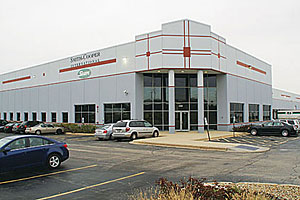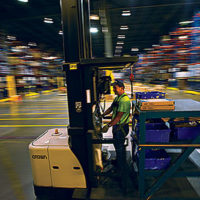
|
| Industrial PVF master distributor Smith-Cooper International further strengthened its customer-service capabilities by expanding into this 127,000-sq.-ft. facility in Elk Grove Village, Ill., a Chicago suburb. Photo courtesy of Smith-Cooper International |
Trends and forecasts always are frequent topics of discussion in the PHCP/PVF industry.
That definitely holds true for the master distribution end of the equation. A group of master distribution executives recently spoke with Supply House Times on a variety of topics related to their companies’ roles in the industry. The group is in agreement that the master distributor will continue to gain prominence this year and beyond.
“During the Great Recession inventory at the wholesale level became a sensitive issue and a major concern,” says Bob Cooper, president of Commerce, Calif.-based industrial PVF master distributor Smith-Cooper International. “Once inventories depleted, the role of the master distributor became even greater. In a relatively short amount of time, we were expected to have available the inventory the wholesalers didn’t have. Inventory management became a much more critical part of the wholesale business, which has a direct influence on the role of the master distributor.”
F.W. Webb Co. Senior Vice President Industrial-PVF Business Development Ernie Coutermarsh says the current climate is all about supply and demand. “The supply house’s mission has not changed. Inventory matters,” he says. “What has changed is that manufacturers don’t want inventory and neither do industrial customers. Things such as outsourcing, lean manufacturing, vendor-managed inventory, just-in-time delivery, customer focus on indirect and MRO cost have created opportunity for those that can invest in inventory. To fill the gap created by the lack of manufacturer and customer buffer inventories, master distributors see an opportunity to capitalize. Someone has to have the inventory and urgency is a major factor because unplanned events drive MRO.”
To deal with that growth, master distributors are going on the offensive and strengthening infrastructure. For example, Los Angeles-based industrial PVF master distributor Industrial Valco is expanding its machine-shop capabilities to include taper boring, through boring, flange facing, valve bypasses and gear operators. The company has a certified welder on staff and has hired industry veteran Javier Vergara to further bolster its quality-control operations.
“We always are looking to add more value to the trade channel and our distributor customers,” Industrial Valco President Rob Raban says. “We’re always looking to improve our stock of inventory and our service offerings.”
In addition to facilities in Los Angeles, Atlanta and Vancouver, Smith-Cooper recently expanded into a 127,000-sq.-ft. facility in Elk Grove Village, Ill., just minutes from Chicago O’Hare International Airport.
“We needed to increase our service capability to our customers in the Midwest region,” Cooper says. “As a supplier/master distributor, your business logistics and value-added has to support your customers’ ever-changing demands.”
In terms of forecasting, Kessler Sales and Distribution Vice President and General Manager Tim Hagan sees a better landscape in 2014 and a bright future for master distribution in general.“The metrics are better for 2014, but the recent history of starting and stopping would lead me to qualify my outlook as guardedly optimistic,” he says.
“I am optimistic about the future role of master distributors. Business is getting transacted much faster and more efficiently today than five years ago. I can only imagine that five years from now the customer’s expectations will continue to evolve and that will put increasing pressure on the supply chain. I think the master-distribution channel will be well-positioned to respond to these pressures, and their value proposition of shrinking time and space will be perfectly positioned to deliver results.”





